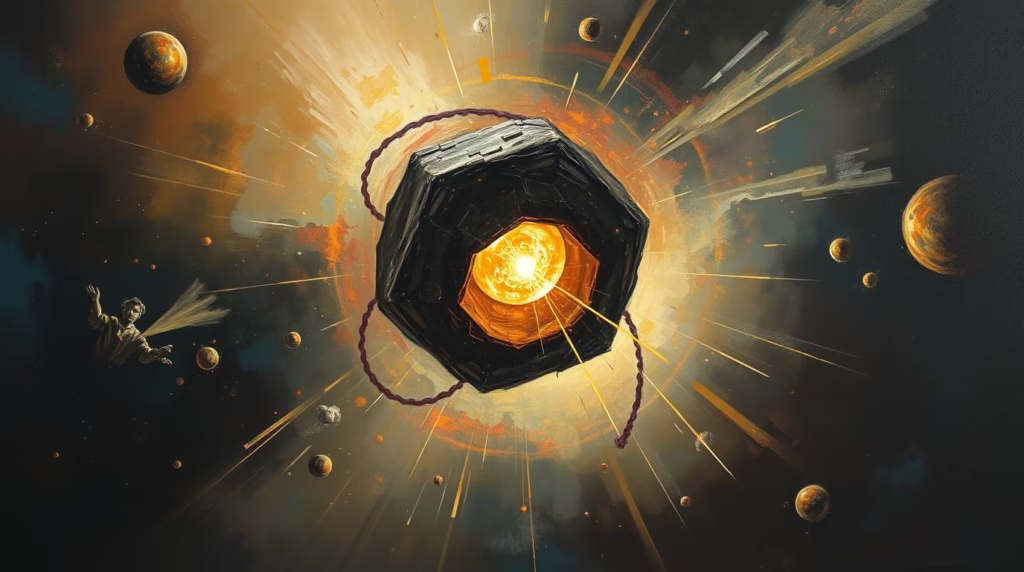A Mysterious Object Released Into Orbit by Russian Military Satellites: Unveiling a Potential New Threat in Space?
On February 2, 2025, Russia propelled three enigmatic satellites—Kosmos 2581, Kosmos 2582, and Kosmos 2583—into Earth’s orbit, launched atop a Soyuz-2.1V rocket from the Plesetsk Cosmodrome. Positioned approximately 585 kilometers above the planet’s surface, these satellites have swiftly piqued the curiosity of global space experts. Their peculiar orbital behavior, coupled with the release of an unidentified object into space, has sparked widespread apprehension about Russia’s potential militarization of the cosmos.
This article delves into the historical context of the Kosmos program, the odd activities of these satellites, and the implications of the mysterious object they’ve introduced into orbit. With an eye toward SEO optimization, we explore whether this development signals a new era of space-based threats.
The Kosmos Program: Decades of Clandestine Space Operations
The Kosmos program, birthed in 1962 during the Soviet era, stands as a cornerstone of Russia’s secretive space endeavors. Originally conceived to pioneer cutting-edge satellite technologies, its primary focus has historically leaned toward military applications. Over the decades, the program has engineered satellites for reconnaissance, electronic surveillance, and even experimental weaponry, cementing its reputation as a shadowy pillar of Russia’s space strategy.
Throughout its existence, the Kosmos initiative has been shrouded in mystery. Many of its missions have served dual purposes—some benign, such as satellite maintenance and repair, and others more ominous, like testing antisatellite (ASAT) systems. For instance, the program has demonstrated capabilities in satellite inspection, enabling close-proximity operations in orbit. These advancements allow Russia to monitor, manipulate, or potentially disable rival spacecraft—a testament to its growing prowess in space warfare.
The launch of Kosmos 2581, 2582, and 2583 aligns seamlessly with this legacy. While Russia remains tight-lipped about their specific purposes, the historical precedent suggests these satellites could be part of an advanced military operation. Could they be testing new technologies to assert dominance in space? The absence of clear answers only heightens global unease.
Unusual Orbital Maneuvers: A Sign of Military Intent?
Once deployed into a near-polar orbit, the trio of satellites wasted no time drawing scrutiny. Analysts noted their ability to execute intricate maneuvers, hinting at interactions with other orbital objects. Such behavior is rare for civilian satellites and is more commonly linked to military objectives, such as satellite surveillance, reconnaissance, or even weapon testing.
What’s particularly striking is their apparent formation flying. Operating in a coordinated pattern, Kosmos 2581, 2582, and 2583 exhibit a level of precision that suggests a deliberate mission. Formation flying is a hallmark of rendezvous and docking operations—techniques often employed in military contexts. For example, these maneuvers could facilitate the deployment of repair drones, the inspection of foreign satellites, or even the testing of technologies designed to disrupt enemy spacecraft.
Space experts speculate that these activities might be a rehearsal for antisatellite operations. Russia has a documented history of exploring ASAT capabilities, including a 2021 test that destroyed one of its own satellites, generating a cloud of debris that threatened the International Space Station. With tensions rising in the global space race, the possibility that these satellites are part of a broader strategy to neutralize adversaries’ orbital assets cannot be dismissed.
The Enigma of the Mysterious Object
The plot thickened on March 18, 2025, when a new object appeared in orbit, apparently ejected from Kosmos 2581. The U.S. military was quick to detect this anomaly, and since then, space analysts have kept it under close watch. Yet, Russia has offered no official statement regarding its identity or purpose, leaving the international community to speculate.
Renowned astrophysicist and expert in orbital activities Jonathan McDowell has offered his thoughts on the subject. He posits that the object could be part of an experiment to refine satellite interaction techniques. “This might be a trial run for docking mechanisms or a method to interfere with other satellites,” McDowell noted in a recent analysis. His insights underscore the dual-use potential of such technology—capable of both constructive and destructive applications.
Could this object be a prototype for an anti-satellite weapon? The notion isn’t far-fetched. Russia’s track record includes the development of “killer satellites” capable of disabling or destroying rival spacecraft. Alternatively, it might be a benign component, such as a calibration tool or a scientific instrument. However, the mission’s opacity and Russia’s reluctance to disclose details tilt the scales toward a military explanation.
The object’s presence raises critical questions about space security. If it is indeed a weapon—or a precursor to one—it could herald a new chapter in orbital warfare, where nations vie for supremacy beyond Earth’s atmosphere.

Global Concerns: A New Frontier in Space Warfare?
The deployment of Kosmos 2581, 2582, and 2583, along with the mysterious object, arrives at a time of heightened geopolitical tension. Space has become an increasingly contested domain, with major powers like the United States, China, and Russia investing heavily in orbital capabilities. The U.S. Space Force, established in 2019, reflects this shift, emphasizing the need to protect national interests in space.
Russia’s actions amplify these concerns. Its past ASAT tests and satellite-inspection missions suggest a strategic intent to dominate the orbital battlefield. The Kosmos trio’s behavior—coupled with the unidentified object—fits this pattern, potentially signaling an escalation in space-based military tactics.
What Lies Ahead?
As of April 8, 2025, the purpose of Kosmos 2581, 2582, and 2583—and the object they’ve released—remains a puzzle. Are they benign tools of exploration or harbingers of a militarized space race? Without transparency from Russia, the international community is left to interpret the clues.
The Kosmos program’s history offers a lens through which to view these developments. Its blend of innovation and secrecy has long fueled speculation about Russia’s ambitions in space. Today, with advanced technologies enabling everything from satellite repair to orbital combat, the stakes are higher than ever.
For now, space analysts will continue tracking these satellites and their mysterious companion. The data they gather could reveal whether this is a routine mission or a bold step toward weaponizing the final frontier. One thing is certain: the world is watching, and the answers could redefine humanity’s relationship with space.
Conclusion
The launch of Kosmos 2581, 2582, and 2583, followed by the release of an unidentified object, has thrust Russia’s space activities into the spotlight. From their unusual orbital maneuvers to the legacy of the Kosmos program, every detail suggests a military undertone. As space becomes a theater for geopolitical rivalry, this development serves as a stark reminder of the challenges ahead. This enigmatic object in orbit requires attention—and vigilance—whether it is a threat or a test of technology.
for more interesting news.. visit BulletinBuzzs
